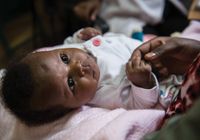The Newborn Health in Humanitarian Settings: Field Guide (Field Guide; NBFG) provides guidance and tools to reduce neonatal mortality and morbidity in all kinds of humanitarian crisis situations. It is designed as a programming and advocacy tool to aid humanitarian and development actors in ensuring the inclusion and provision of critical newborn health services in a crisis response; it is not a clinical guide.
The Field Guide focuses on the unique challenges surrounding the 28-day neonatal period following birth. It complements guidance provided by the 2018 Inter-agency Field Manual on Sexual and Reproductive Health in Humanitarian Settings (IAFM)[1] for building sexual and reproductive health and rights (SRHR),info including maternal and newborn health, along a comprehensive continuum of care. The IAFMabbreviation includes the MISPabbreviation, which describes essential services to be implemented at the onset of an emergency response with recommendations and guidelines for the establishment of more comprehensive SRHabbreviation services as situation stabilizes. The provision of critical newborn health services is part of the MISPabbreviation, yet humanitarian health actors have historically neglected newborn care.
The Field Guide seeks to address this gap by building on the IAFMabbreviation guidance and focusing on field implementation of the most critical newborn health services, prioritizing lifesaving activities that can be introduced relatively quickly, without specialist training in advanced newborn care. It provides guidance regarding the initiation of newborn health services during the acute phase of a humanitarian crisis as well as the enhancement and expansion of these services over time, as the setting allows. The Field Guide can also be used for the development of the neonatal component of national emergency preparedness and response plans. Ensuring newborn health is integrated into emergency preparedness efforts is critical to ensure that newborn health needs are addressed during the response phase.
The information provided in this Field Guide focuses on the first month of life because of vulnerability to death and disability in the neonatal period and high mortality of newborns in humanitarian settings. However, the Field Guide should not be viewed as a “stand-alone” package. All newborn services should ideally be delivered within a life course approach that provides comprehensive quality reproductive and sexual health services for women and girls through to early childhood development.
Specific areas that are not covered in this guide, but are critical complementary packages to these core newborn health services include maternal health care and maternal mental health; PMTCT; WASHabbreviation; nutrition interventions; early childhood development; immunization; and protection services.
The epidemiology, interventions and services highlighted in this Field Guide are not unique to humanitarian settings. Information presented here is derived from existing WHO standards and guidelines on the basic care required for all newborn babies, and services to prevent and manage the three main causes of newborn mortality: prematurity, infections and intrapartum-related events.
Yet the provision of this care in a humanitarian setting presents distinct challenges. By definition, humanitarian crises entail difficult operating environments, frequently involving logistical challenges, inadequate supplies, limited staff and insecurity. Field staff are faced with complex situations requiring difficult decisions. In addition, advocacy is critical to ensure newborn needs are prioritized by humanitarian responders, and successful program implementation is contingent on effective coordination with partners. This Field Guide provides practical guidance on advocacy, programming, coordination and strategy to help field staff make informed decisions and thus make a positive impact on newborn health.

